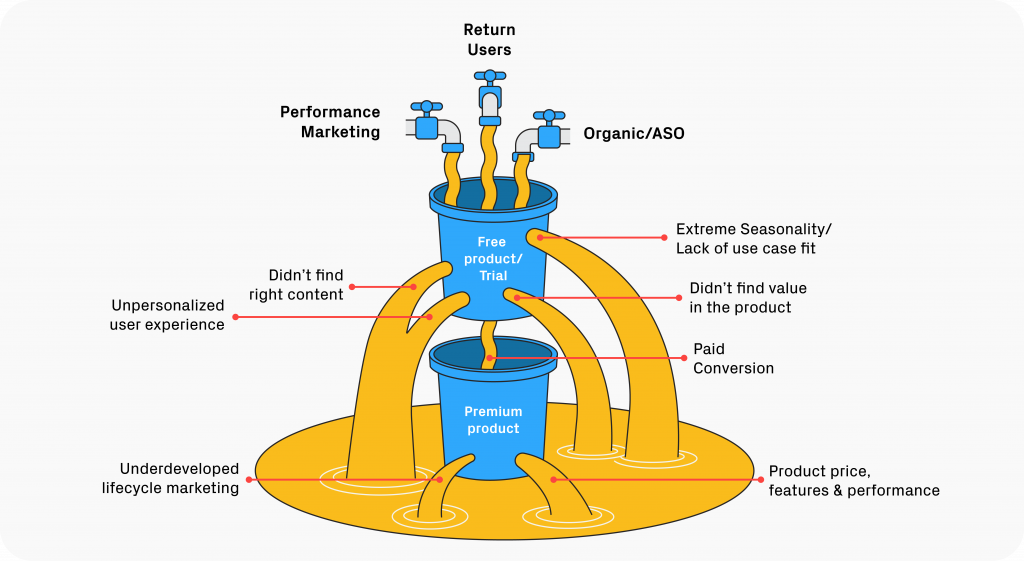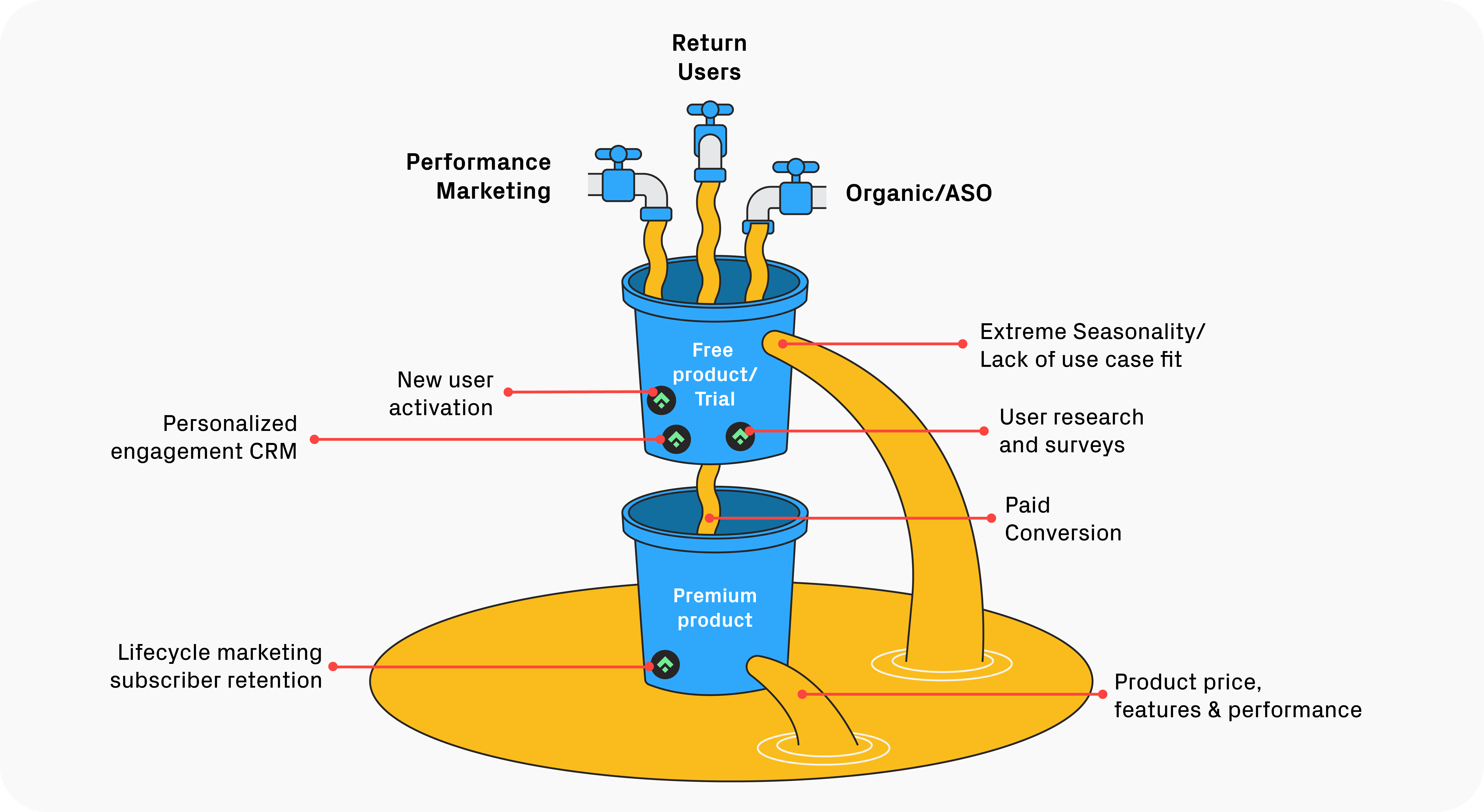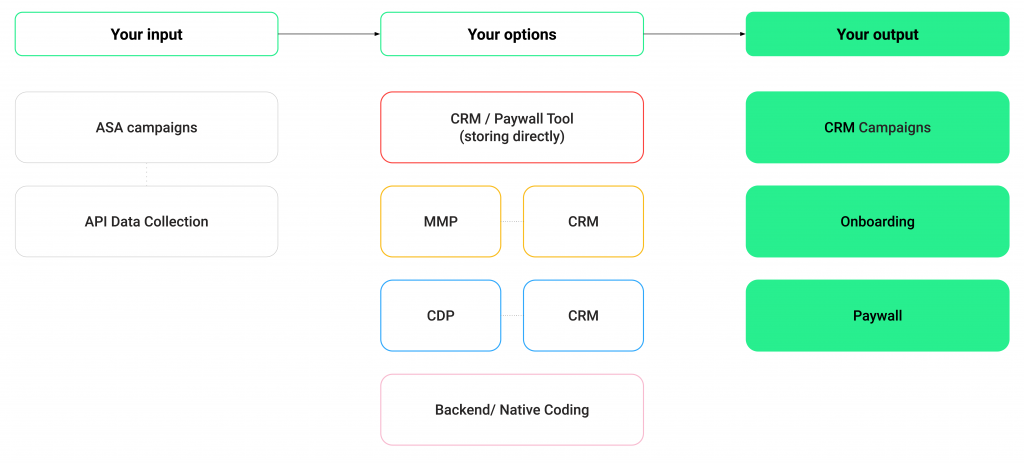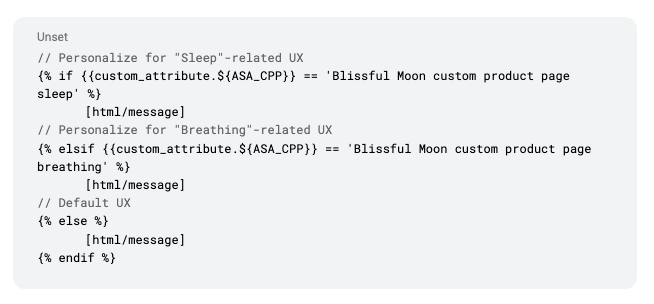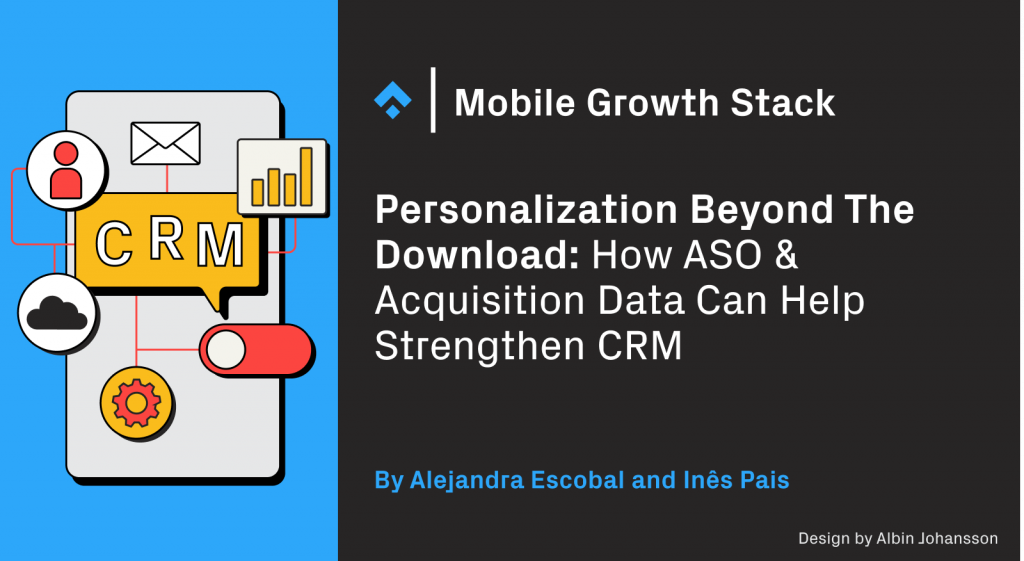
Personalization is the foundation of successful retention and CRM strategies. The introduction of Custom Product Pages with iOS 15 brought consistency of design and messaging with the original traffic source, but what happens after the download?
In this article, we’ll illustrate how acquisition data can strengthen later retention strategies to further personalize the user journey. In particular, we’ll show how to integrate attribution data into CRM campaigns to unlock continuity across the user journey: From ads to the app stores to the whole in-app UX.
This article is divided into two parts. In part one, the strong foundations required to ensure continuity in user experience are introduced, alongside the importance of effective collaboration between the different functions of Growth Teams. In part two, a use case that leverages acquisition data in order to inform in-depth retention strategies is presented, showing how by piping attribution data from CPPs into a CRM tool, the post-download user experience can be personalized.
Building a solid foundation for growth
In today’s competitive digital landscape, acquiring users at scale is only one part of the equation towards growth. Retaining users and fostering strong customer relationships is also essential for a product to grow sustainably.
By nature, ASO and Performance Marketing are focused on top-of-the-funnel marketing initiatives such as awareness, discovery and conversion. CRM – also known as Lifecycle Marketing – is focused on bottom-of-the-funnel stages such as onboarding, activation, and monetization, that ensure retention and prevent churn.
CRM’s importance in the funnel is illustrated through the metaphor of leaky buckets. Imagine if all your users were water, and newly added to buckets by acquisition. These buckets have holes that represent the user experiences likely to lead to churn.
When users are added to your buckets, there are common scenarios where your bucket is likely to spring a leak, as illustrated above.
Important factors such as the app’s perceived value, the user finding content relevant to them, and having a personalized user experience, all play a crucial role as to whether your users will stay in the bucket – or flow out.
Effective CRM and retention strategies help users find the app’s core value, activate them, and provide a personalized experience. When executed well, this will help you compensate the Cost Per Acquisition (CPA) with a higher Lifetime Value (LTV), driving app – and ultimately, a business’s – growth.
Effective CRM and retention tactics stem the leaks, as illustrated by Phiture logos.
Continuity is key for great user experiences, and we can’t emphasize this point enough. For this end, aligning Retention, Performance Marketing, ASO, and any other Growth functions, to work together towards the same goal is crucial for your product to succeed.
For example, user onboarding doesn’t start when the app is downloaded. It extends to your ads and your landing pages, and starts when your ad is served or a user finds an app on the store through search. Onboarding then continues in the app, by restating the value proposition, educating the user, and activating them on key features. The ultimate goal is to have continuity in the user experience — from the moment the user first becomes aware of your product, to the moment they become an engaged and active user.
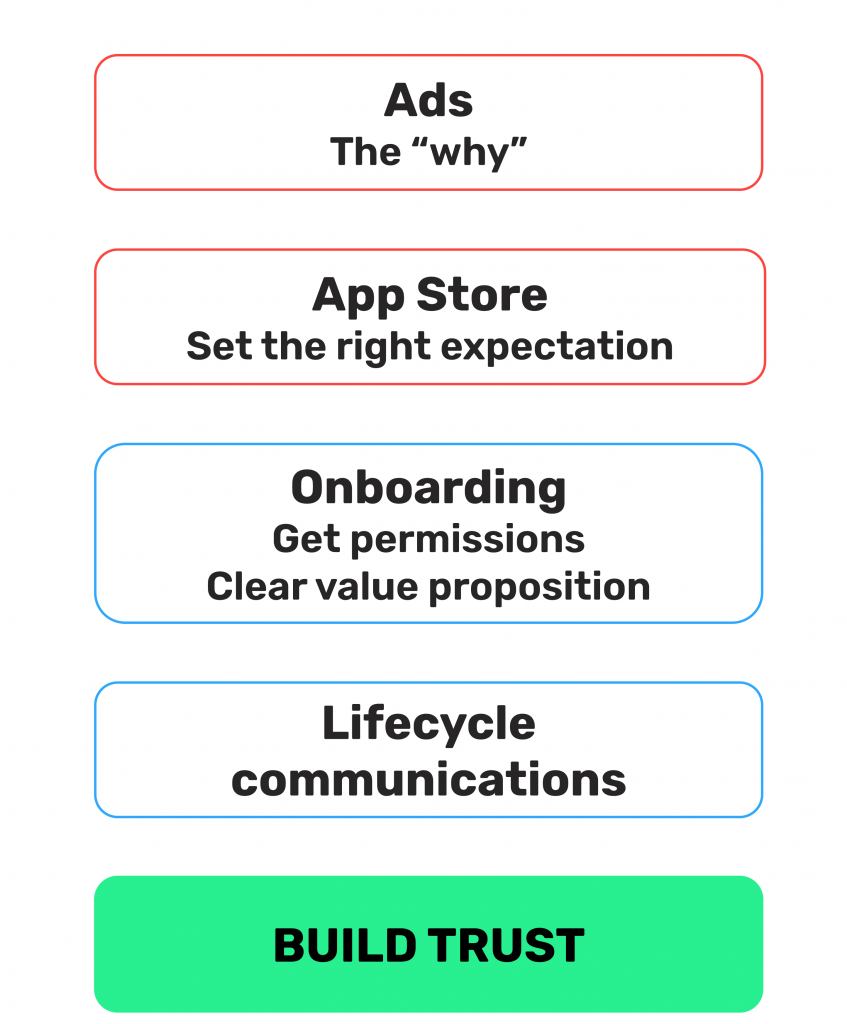 Continuity in the user experience to build trust.
Continuity in the user experience to build trust.
This continuity across the user experience, when combined with the appropriate personalization, inspires trust and maximizes engagement and retention.
Personalization plays a pivotal role in this process and wider CRM strategies. When executed correctly, personalization is the biggest opportunity to optimize the customer experience, improve retention, and increase revenue.
Industry studies and reports have long established the link between a personalized experience and positive impacts to consumer behavior:
- 56% of consumers are more likely to become repeat buyers after a personalized experience*.
- 49% of Gen Z say they’re less likely to make a purchase and 27% say they’ll stop engaging with the brand or share the negative experience with their circle after an impersonal experience*.
- CRM channel engagement benchmarks point to a 40% uplift in in-app message click rates when personalization is utilized**.
*Segment, The State of Personalization Report 2023
** Braze, The Power of Personalization
Leveraging Acquisition and CRM data to inform both strategies
Throughout the user’s lifecycle, apps can leverage several data points and insights from ASO and Performance Marketing to inspire strong relationships with the user that power retention and engagement. However, CRM data can also play a role in optimizing Acquisition strategies as part of a virtuous loop.
How data can inform strategies for user engagement at each lifecycle stage
Use cases for leveraging Acquisition and CRM data
- Onboarding personalization. Attribution data can be used early on to inform early-stage personalization once a new user lands on your app for the first time. For example, by leveraging integrations with your Mobile Measurement Partner (MMP) or your Apple Search Ads (ASA) to find out which ads or search-intents are bringing new users, you can then tailor the first-time user experience accordingly. This could be as simple as personalizing a welcome email to emphasize the value proposition and features most valuable to a user based on their search intent; or it could mean changing in-app screens based on that knowledge. (We will be looking at this use case more in-depth later in this article).
- Behavioral insights. As users become engaged and committed, CRM and behavioral data can be used to inform and continuously optimize your ASO and Paid Marketing strategies: for example, you could iterate your app store landing pages, your ads, and your creative strategies based on what you learn is your user’s ‘critical path’ and key activation events (i.e. those that correlate with long-term retention).
- Improving app ratings. As key behavioral patterns become apparent and you can identify key cohorts of users, you can also begin to prompt custom user segments to review your app or share valuable feedback about their experience in the product. For example, you could build a cohort of “power users” (e.g. those who performed [X] key action with [X] frequency and experienced 0 app crashes in the last [X] days) whom you would target with a custom-built in-app message flow that nudges them with pre-prompts to rate the app; then, based on their reply, (if positive) you might direct them to the store to leave a review, or (if negative) you might let them write feedback shared directly with your customer support team.
- Retarget dormant users. When users become disengaged with your product and are at risk of churning, In-App Events can be used to grab their attention back in the app store and attempt to bring them back with enticing messages, product updates, and offers.
- Braze Audiences. Lastly, integrations between your CRM and Acquisition channels can help retarget churned users and optimize ad spend. For example, Braze Audiences – which includes integrations with Meta, Google, TikTok, Snapchat, and Pinterest – can help optimize and personalize acquisition by creating exclusion targeting lists, retargeting lists, or even lookalike audiences.
The importance of the tech stack
To action these use cases, a robust tech stack is a must. The right tech stack will allow different teams to access, process, and utilize data to build stronger strategies across the board, while enabling a seamless integration and collaboration between different Growth functions. That said, it’s important to know and understand your company’s overall tech stack, and not just your own department or team’s stack. An overarching appreciation will allow for the leveraging of relevant pieces of data from all data sources, and maximize the cross-over potential. In other words, by looking beyond the obvious tools and data sources used within a particular growth function on a day-to-day basis, there may be potential to unlock new opportunities for collaboration, data sharing, and personalization.
Common MMPs and analytics platforms.
Personalizing beyond CPPs by piping acquisition data into your CRM
Customer Product Pages (CPPs) have helped make the App Store user experience and acquisition journey more relevant by enabling marketers to provide consistent messaging and product page design between a traffic source and a landing page. This is very valuable, but marketers can go one further, by using CPP data to inform later CRM. Let’s first take a look at how CPPs have enhanced the user journey.
The value of CPPs
For an instructive look at Custom Product Pages (CPPs) take a look at our Playbook where we deep dive into use cases, design, how to link CPPs to various traffic sources, and how to measure the performance of CPPs.
To illustrate the value of CPPs, let’s look at Blissful Moon, a hypothetical meditation app. Before the CPP era, no matter what keywords a user might search with, users would always see the same default set of three screenshots in the search results.
An example of three typical screenshots a user would see with ‘Blissful Moon,’ prior to CPPs.
With CPPs however, users can receive a much more personalized experience based on search intent, demographic traits, or special events. In fact, post iOS 15, from the moment a CPP is uploaded, users will rarely see the default screenshot set.
How CPPs can show different screenshots to different keywords and search intents.
In the example above, the user might search for meditation-related keywords or sleep-related keywords, and get completely different results for the same app.
At Phiture, we have seen an average 30% improvement in conversion rate and a 25% drop in cost per acquisition with intent-based CPPs. (Average CR and CPA results from Phiture clients; not tied to any specific app or industry). In spite of these improvements no matter how many CPPs are uploaded, it’s likely the post-install experience stays the same for everyone, regardless of which search-intent or CPP led each user to the app.
Unless, of course, we can make this journey even more relevant and streamlined by expanding it beyond the ad. For example, by tailoring the welcome screen or paywall users see upon opening the app.
Returning to our Blissful Moon example, if a user converted from the CPP for the keyword “sleep,” we could ensure continuity by showing a welcome screen and paywall where the “sleep” USP is emphasized.
How user journeys can be crafted post install to match original search intent.
This continuity between search, CPPs, and UX could result in a higher LTV and long-term retention.
Implementation of post-install journeys, step-by-step
For an integration between acquisition data and in-app experience to be possible, it’s key to ensure attribution data is available for in-product personalization, or for supporting tools such as your CRM or your Paywall management tool.
In the example below, Apple Search Ads are the source of acquisition data and Braze is the CRM tool used to personalize campaigns. However, there are other data sources that can provide valuable input, as well as other CRM tools that can be leveraged for this.
At a high-level, we can break this process down into three steps.
Step One: The Input
In our example, we are running ASA campaigns which are specifically aligned with CPPs that focus on specific app features or USPs.
ASA data points can be leveraged for in-app personalization based on a number of traits: from campaign-level attributes (campaign name and placement), to ad group-level attributes (ad group name, gender, age, CPP name, location), and keyword-level attributes (keyword text, broad/exact targeting).
Step Two: Attribution
We then need to fetch attribution-related information and store it for later use. Luckily, there’s multiple ways to go about that:
- The native solution. In this scenario, attribution data is collected and shared with your tools right from your backend. Of course, this requires an Engineering Team’s involvement before the Acquisition and CRM teams can independently play around with personalization strategies. The upside is that it gives you access to a much wider range of data points, as well as flexibility into how those are stored for later use.
- Leverage available connectors and no-code integrations. A much easier solution, which reduces reliance on the Engineering team’s availability, and leverages available connectors and no-code integrations to toggle on this data in the relevant tools. For example, you could use the often available out-of-the-box integrations between MMPs and CRM tools to get information about which ad, ad group, ad campaign, or source a given user has installed the app from. Alternatively, if you use a Customer Data Platform (CDP), you could pipe selected relevant data points through the CDP and into your tools.
Step Three: The Output
Finally, we will be able to produce the desired output: use the stored attribution information to personalize CRM campaigns, onboarding flows, or paywalls.
Deep-dive: How to store and make available attribution data natively
As mentioned above, a native solution for storing and accessing attribution data can make available a wider range of data points, however, it requires engineering resources. In this section, we take a deep dive into how to do this.
Attribution data can be requested, collected, stored, and shared with third-party tools directly from your backend.
To do so, you need to have the AdServices framework implemented. This is Apple’s most recent attribution framework and lets you track your campaigns’ performance. However, keep in mind that this is only supported for devices running iOS 14.3 or higher.
With the AdServices framework, you can request an attribution token for each user which is generated regardless of whether they opened the app from an ASA campaign or not. The token can be provided to an MMP or you can use it to fetch attribution records directly from Apple’s attribution server.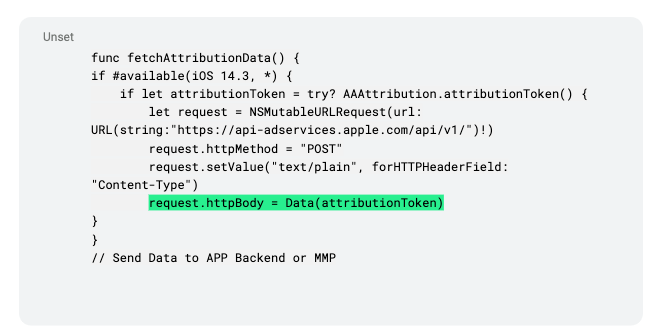
The token can then be used to request an attribution payload containing key information about which ad a user might be coming from. This attribution record is a simple data dictionary containing key-value pairs that correspond to attributes of your Apple Search Ads campaigns.
Equipped with an attribution adId, adgroupId, and campaignId, you can call the ASA API to fetch additional information necessary for personalization. This is a short snippet of what the response would look like, but besides creativeId and name, you can also get information about the creative type, status, and much more.
The results can be stored in your CRM as user attributes in each user’s profile and can be accessed at any time for future use.
 The data is now available in your CRM Tool and you can start personalizing!
The data is now available in your CRM Tool and you can start personalizing!
For example, you can have one CPP for “sleep”-related searches and a second one for “breathing”-related searches, while still serving the default brand experience to all other intents (or lack of them).
As illustrated with Blissful Moon, you can now configure your CRM you so that the welcome screen and paywall are based on the ad group name, CPP, or keyword.
No-code? No problem! How to leverage MMPs and CRM tools
Easier, no-code alternatives are often preferable when engineering resources are scarce or the effort is just not justified when out-of-the-box connectors are made available by MMPs and CRM tools.
CRM tools like Braze offer out-of-the-box integrations with a variety of other third-party tools for message personalization, orchestration, and analytics. The integrations with Customer Data Platforms (CDPs) and MMPs allow Growth Teams to easily setup these data pipelines with little to no dependence on Engineering, nor the need to wait for an upcoming app release.
This means attribution data such as source, campaign, ad group and ad can be readily available in a user’s profile for use in message personalization, effectively enabling you to skip all the complicated setup steps that an engineer would need to go through.
Source: Appsflyer
Technically speaking, this is what the actual step-by-step might look like natively:
This is what a step-by-step would look like using available connectors, such as Braze.
Note: You will need to have installed both the Braze SDK (or alternative CRM SDK) and the MMP SDK before you start the integration. More information here.
Wrap-Up
Personalizing the user experience can be extended from the initial conversion to in-app CRM, by piping acquisition data into the appropriate tools that enable post-download experience personalization.
As shown throughout this article, achieving continuity in the user journey from discovery to long-term retention requires close partnership and collaboration across all Growth functions, to align strategies, initiatives and resources.
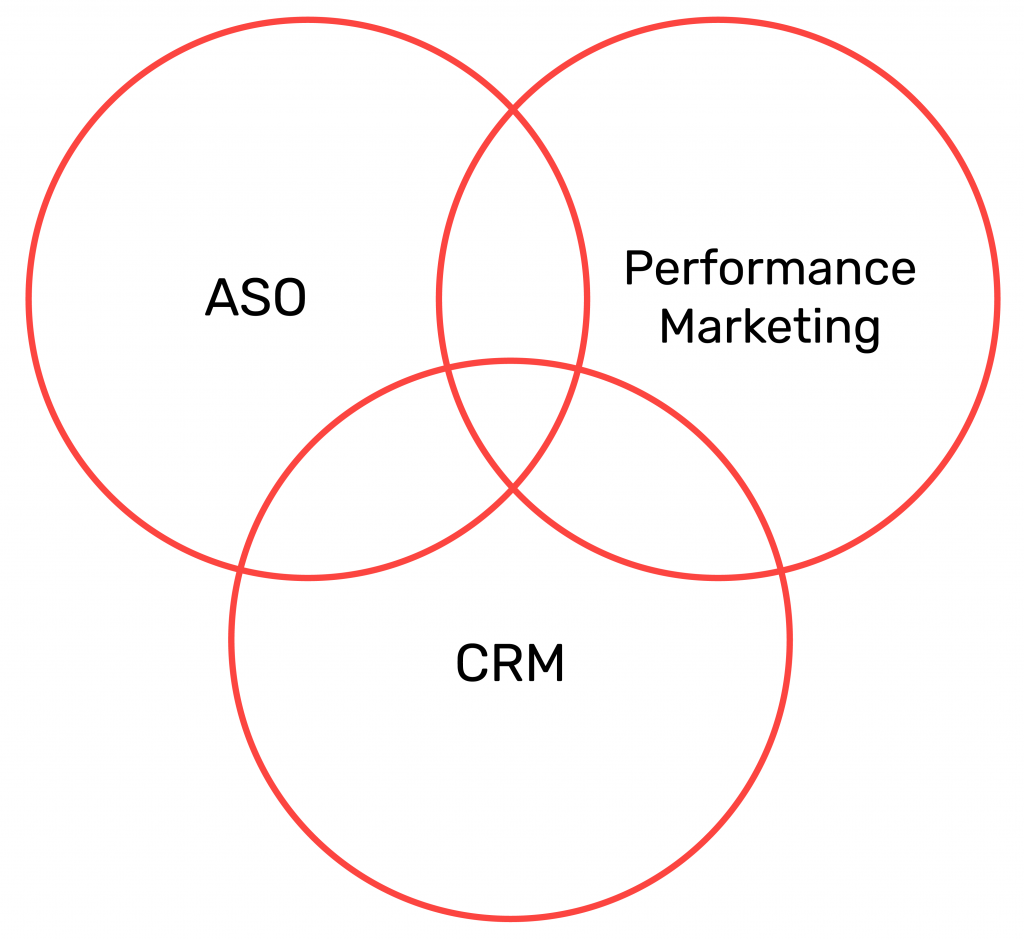
Typically CRM is in charge of implementation and provides the data for acquisition. However, Product and Growth Teams inform the CRM Team about key features and core user behaviors that correlate with user retention.
Meanwhile the ASO team owns the keyword research, ensures organic discoverability, and informs the CPP strategy, while the Performance Marketing Team owns ASA implementation, manages ads, and provides powerful data to CRM.
Before You Go
- Custom Product Pages are a very handy way to simplify and facilitate user journeys which end in conversion. Our Playbook has proven very popular with marketers and is instructive in their use, with some useful best practice advice included.
- Phiture’s Subscription Stack is designed to help growth marketers conceptualize their subscription optimization strategy and understand the essential components of running a mobile subscription business. CRM is vital across the stack, and you can check it out here.
- Phiture’s Mobile Growth Stack Slack Community brings together professionals from around the world, who are engaging with technology like Liquid to supercharge their CRM strategy. Join today to stay on top of the latest industry updates and trends, pose questions (or answer them), and connect with fellow mobile growth marketers.
Table of Contents

